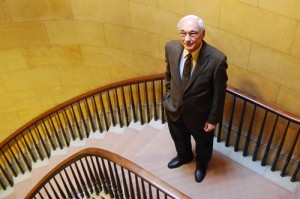Paoletti Honored at Art History in Renaissance Symposium

Dante, Bolognese poetry, Leonardo and Quattrocento were among the topics addressed at the Art and History in Renaissance Italy Symposium May 1-2 on campus.
The event was held in honor of John Paoletti, Kenan Professor of the Humanities, professor of art history, who is retiring in May. Paoletti is an internationally-prominent scholar in art history with much of his work focused on the Italian Renaissance.
“This symposium is a unique one that honors John’s 37 years of service to Wesleyan, and his foundational role in developing the university’s program in Art History,” says Joseph Siry, professor of art history. “The symposium consisted of papers given by scholars in this field, who came to Wesleyan from around the United States, each of whom has had a special professional connection to John’s career.”
Art and Literature was the subject of talks on May 1. Judith Brown, professor of history, was the moderator. Debra Pincus, from the National Gallery of Art, Washington, D.C., spoke on “When Did Dante Get to Look like Dante?”
Daniel Zolli ‘07 discussed “The ‘Hypnerotmachia Poliphili’ (1499) and Aldus Manutius’ Humanist Literary Enterprise.”
Nadja Aksamija, assistant professor of art history, lectured on “Sacralizing the Bolognese Landscape: Architecture, Poetry, and the Counter-Reformation Villa.”
Quattrocento Art and Patronage was the subject of talks on May 2. Clark Maines, Kenan Professor of the Humanities, professor of art history, professor of medieval studies, was the moderator. Presenters and their topics included:
Shelley Zuraw, from the University of Georgia, spoke on “What Brunelleschi Learned in Pistoia: The Competition Panel Again.”
Sharon Strocchia, of Emory University, discussed “Abbess Piera de’ Medici and Artistic Patronage at S. Verdiana, Florence, c. 1450.″
David Drogin, of the Fashion Institute of Technology, State University of New York, spoke on “Sculpture, Patronage, Emulation and the Bentivoglio of Bologna.”
Cinquecento and Sculpture Art and Literature was the subject of talks for the third session on May 2. Laurie Nussdorfer, professor of history, professor of letters, served as the moderator. Presenters and their topics included:
William Wallace, of Washington University, St. Louis, discussed “On Location…or why go? Reflections on Conducting Research in Italy.”
Gary Radke, of Syracuse University spoke on “Leonardo, Student of Sculpture.”
Roger Crum, of the University of Dayton, discussed “Pieces, and, Yes, Masterpieces: The Use of Crying over Spilled Marble in Renaissance Florence.”
And Michael Cole, of the University of Pennsylvania, spoke on “Clothed Men in Piazza.”
All three sessions will concluded with questions and discussion. A reception for all symposium participants and attendees was held in the Russell House.
A private dinner at the Inn at Middletown following the symposium honored Paoletti, who came to Wesleyan in 1972, with the idea that he would work to build a program in art history. Gradually, over the course of the next 27 years and under his leadership, the program grew to a faculty of eight full-time appointments, a size larger than many Ph.D programs.
At the dinner, David Drogin ’94, assistant chair of the History of Art Department at the State University of New York, announced that a book is being published in Paoletti’s honor.
Its title is Patronage and Italian Renaissance Sculpture and it is under contract with Ashgate Press, with an expected publication date in 2010. The book is edited by Drogin and Kathleen Christian ’94. Both Drogin and Christian are former students of Paoletti.
“The project had been kept a secret from John, until we announced the book and presented him with a table-of-contents at the symposium dinner,” Drogin says. “It includes chapters by several of the symposium participants, as well as by several other leading Renaissance scholars from around the world.”
During his time at Wesleyan, Paoletti has set standards for teaching and scholarly excellence. While publishing on his first love, the Italian Renaissance, he also produced a series of distinguished exhibitions of 20th century art and accompanying catalogues, making him one of the few scholars active today who publish in two different periods of art history.
“As John’s career at Wesleyan comes to a close, his colleagues will miss the knowledge that he has shared freely, the advice about pedagogy that he has given freely, but most of all his leadership and unfailing goodwill,” Maines says.

